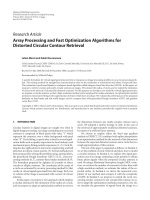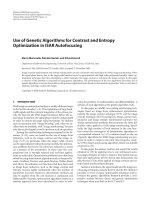Algorithms for Query Processing and Optimization
Bạn đang xem bản rút gọn của tài liệu. Xem và tải ngay bản đầy đủ của tài liệu tại đây (694.89 KB, 81 trang )
Chapter 3
Algorithms for Query Processing and
Optimization
1
Chapter Outline
Introduction to Query Processing
Translating SQL Queries into Relational Algebra
Algorithms for External Sorting
Algorithms for SELECT and JOIN Operations
Algorithms for PROJECT and SET Operations
Implementing Aggregate Operations and Outer Joins
Combining Operations using Pipelining
Using Heuristics in Query Optimization
Using Selectivity and Cost Estimates in Query Optimization
Overview of Query Optimization in Oracle
Semantic Query Optimization
2
Introduction to Query Processing
Query optimization: the process of choosing
a suitable execution strategy for processing a
query.
Two internal representations of a query
– Query Tree
– Query Graph
3
Typical steps
when processing
a high-level query
4
Translating SQL Queries into Relational
Algebra (1)
Query block: the basic unit that can be translated
into the algebraic operators and optimized.
A query block contains a single SELECT-FROMWHERE expression, as well as GROUP BY and
HAVING clause if these are part of the block.
Nested querieswithin a query are identified as
separate query blocks.
Aggregate operators in SQL must be included in the
extended algebra.
5
6
Algorithms for External Sorting (1)
External sorting : refers to sorting algorithms that are
suitable for large files of records stored on disk that do
not fit entirely in main memory, such as most database
files.
Sort-Merge strategy : starts by sorting small subfiles
(runs ) of the main file and then merges the sorted
runs, creating larger sorted subfiles that are merged in
turn.
– Sorting phase: nR = (b/nB)
– Merging phase: dM = Min(nB-1, nR);
nP= (logdM(nR))
nR: number of initial runs; b: number of file blocks;
nB: available buffer space; dM: degree of merging;
nP: number of passes.
7
g 24
a 19
d 31
c 33
b 14
e 16
r 16
d 21
m3
p 2
d 7
a 14
a 19
d 31
g 24
b 14
c 33
e 16
d 21
m 3
r 16
a 14
d 7
p 2
Tạo run
Buffer-size = 3,
a
b
c
d
e
g
19
14
33
31
16
24
a 14
d 7
d 21
m3
p 2
r 16
trộn pass-1
1 record/block
a 14
a 19
b 14
c 33
d 7
d 21
d 31
e 16
g 24
m3
p 2
r 16
trộn pass-2
8
Algorithms for External Sorting (2)
set i 1, j b; /* size of the file in blocks */
k nB;
/* size of buffer in blocks */
m (j/k);
/*number of runs */
{Sort phase}
while (i<= m) do
{
read next k blocks of the file into the buffer or if
there are less than k blocks remaining, then read in
the remaining blocks;
sort the records in the buffer and write as a
temporary subfile;
i i+1;
}
The number of block accesses for the sort phase = 2*b
9
/*Merge phase: merge subfiles until only 1 remains */
set i 1;
p logk-1m; /* p is the number of passes for the merging phase */
j m;
/* the number of runs */
while (i<= p) do
{
n 1;
q (j/(k-1);
/* the number of runs to write in this pass */
while ( n <= q) do
{
read next k-1 subfiles or remaining subfiles (from previous pass)
one block at a time
merge and write as new subfile one block at a time;
n n+1;
}
j q;
i i+1;
}
The number of block accesses for the merge phase = 2*(b* logdMnR)
10
Algorithms for SELECT and JOIN
Operations (1)
Implementing the SELECT Operation:
Examples:
(OP1): σSSN='123456789'(EMPLOYEE)
(OP2): σDNUMBER>5(DEPARTMENT)
(OP3): σDNO=5(EMPLOYEE)
(OP4): σDNO=5 AND SALARY>30000 AND SEX=F(EMPLOYEE)
(OP5): σESSN='123456789' AND PNO=10(WORKS_ON)
11
Algorithms for SELECT and JOIN (2)
Implementing the SELECT Operation (cont.):
Search Methods for Simple Selection:
S1. Linear search (brute force): Retrieve every
record in the file, and test whether its attribute values
satisfy the selection condition.
S2. Binary search : If the selection condition involves
an equality comparison on a key attribute on which the
file is ordered, binary search (which is more efficient
than linear search) can be used. (See OP1).
S3. Using a primary index or hash key to retrieve a
single record: If the selection condition involves an
equality comparison on a key attribute with a primary
index (or a hash key), use the primary index (or the
hash key) to retrieve the record.
12
Algorithms for SELECT and JOIN
Operations (3)
Implementing the SELECT Operation (cont.):
Search Methods for Simple Selection:
S4. Using a primary index to retrieve multiple
records: If the comparison condition is >, ≥ , <, or ≤
on a key field with a primary index, use the index to
find the record satisfying the corresponding equality
condition, then retrieve all subsequent records in the
(ordered) file.
S5. Using a clustering index to retrieve multiple
records: If the selection condition involves an
equality comparison on a non-key attribute with a
clustering index, use the clustering index to retrieve
all the records satisfying the selection condition.
13
Algorithms for SELECT and JOIN
Operations (4)
Implementing the SELECT Operation (cont.):
Search Methods for Simple Selection:
S6. Using a secondary (B+-tree) index : On an
equality comparison, this search method can be used
to retrieve a single record if the indexing field has
unique values (is a key) or to retrieve multiple records
if the indexing field is not a key. In addition, it can be
used to retrieve records on conditions involving >,>=,
<, or <=. (FOR RANGE QUERIES )
14
Algorithms for SELECT and JOIN (5)
Implementing the SELECT Operation (cont.):
Search Methods for Complex Selection:
S7. Conjunctive (AND) selection : If an attribute
involved in any single simple condition in the
conjunctive condition has an access path that permits
the use of one of the methods S2 to S6, use that
condition to retrieve the records and then check
whether each retrieved record satisfies the remaining
simple conditions in the conjunctive condition.
S8. Conjunctive selection using a composite
index: If two or more attributes are involved in equality
conditions in the conjunctive condition and a
composite index (or hash structure) exists on the
combined field, we can use the index directly.
15
Algorithms for SELECT and JOIN (6)
Implementing the SELECT Operation (cont.):
Search Methods for Complex Selection:
S9. Conjunctive selection by intersection of record
pointers : This method is possible if secondary indexes
are available on all (or some of) the fields involved in
equality comparison conditions in the conjunctive
condition and if the indexes include record pointers
(rather than block pointers). Each index can be used to
retrieve the record pointers that satisfy the individual
condition. The intersection of these sets of record
pointers gives the record pointers that satisfy the
conjunctive condition, which are then used to retrieve
those records directly. If only some of the conditions
have secondary indexes, each retrieved record is further
tested to determine whether it satisfies the remaining
conditions.
16
Algorithms for SELECT and JOIN
Operations (7)
Implementing the SELECT Operation (cont.):
Whenever a single condition specifies the selection, we can
only check whether an access path exists on the attribute
involved in that condition. If an access path exists, the method
corresponding to that access path is used; otherwise, the “brute
force” linear search approach of method S1 is used. (See OP1,
OP2 and OP3)
For conjunctive selection conditions, whenever more than
one of the attributes involved in the conditions have an access
path, query optimization should be done to choose the access
path that retrieves the fewest records in the most efficient way.
Disjunctive (OR) selection conditions
17
Algorithms for SELECT and JOIN
Operations (8)
Implementing the JOIN Operation:
Join (EQUIJOIN, NATURAL JOIN)
–
two–way join: a join on two files
e.g. R A=B S
–
multi-way joins: joins involving more than two files.
e.g. R A=B S C=DT
Examples
(OP6): EMPLOYEE DNO=DNUMBERDEPARTMENT
(OP7): DEPARTMENT MGRSSN=SSNEMPLOYEE
18
Algorithms for SELECT and JOIN
Operations (9)
Imp��������������������������������������������������������������������������������������������������������������������������������������������������������������������������������������������������������������������������������������������������������������������������������������������������������������������������������������������������������������������������������������������������������������������������������������������������������������������������������������������������������������������������������������������������������������������������������������������������������������������������������������������������������������������������������������������������������������������������������������������������������������������������������������������������������������������������������������������������������������������������������������������������������������������������������������������������������������������������������������������������������������������������������������������������������������������������������������������������������������������������������������������������������������������������������������������������������������������������������������������������������������������������������������������������������������������������������������������������������������������������������������������������������������������������������������������������������������������������������������������������������������������������������������������������������������������������������������������������������������������������������������������������������������������������������������������������������������������������������������������������������������������������������������������������������������������������������������������������������������������������������������������������������������������������������������������������������������������������������������������������������������������������������������������������������������������������������������������������������������������������������������������������������������������������������������������������������������������������������������������������������������������������������������������������������������������������������������������������������������������������������������������������������������������������������������������������������������������������������������������������������������������������������������������������������������������������������������������������������������������������������������������������������������������������������������������������������������������������������������������������������������������������������������������������������������������������������������������������������������������������������������������������������������������������������������������������������������������������������������������������������������������������������������������������������������������������������������������������������������������������������������������������������������������������������������������������������������������������������������������������������������������������������������������������������������������������������������������������������������������������������������������������������������������������������������������������������������������������������������������������������������������������������������������������������������������������������������������������������������������������������������������������������������������������������������������������������������������������������������������������������������������������������������������������������������������������������������������������������������������������������������������������������������������������������������������������������������������������������������������������������������������������������������������������������������������������������������������������������������������������������������������������������������������������������������������������������������������������������������������������������������������������������������������������������������������������������������������������������������������������������������������������������������������������������������������������������������������������������������������������������������������������������������������������������������������������������������������������������������������������������������������������������������������������������������������������������������������������������������������������������������������������������������������������������������������������������������������������������������������������������������������������������������������������������������������������������������������������������������������������������������������������������������������������������������������������������������������������������������������������������������������������������������������������������������������������������������������������������������������������������������������������������������������������������������������������������������������������������������������������������������������������������������������������������������������������������������������������������������������������������������������������������������������������������������������������������������������������������������������������������������������������������������������������������������������������������������������������������������������������������������������������������������������������������������������������������������������������������������������������������������������������������������������������������������������������������������������������������������������������������������������������������������������������������������������������������������������������������������������������������������������������������������������������������������������������������������������������������������������������������������������������������������������������������������������������������������������������������������������������������������������������������������������������������������������������������������������������������������������������������������������������������������������������������������������������������������������������������������������������������������������������������������������������������������������������������������������������������������������������������������������������������������������������������������������������������������������������������������������������������������������������������������������������������������������������������������������������������������������������������������������������������������������������������������������������������������������������������������������������������������������������������������������������������������������������������������������������������������������������������������������������������������������������������������������������������������������������������������������������������������������������������������������������������������������������������������������������������������������������������������������������������������������������������������������������������������������������������������������������������������������������������������������������������������������������������������������������������������������������������������������������������������������������������������������������������������������������������������������������������������������������������������������������������������������������������������������������������������������������������������������������������������������������������������������������������������������������������������������������������������������������������������������������������������������������������������������������������������������������������������������������������������������������������������������������������������������������������������������������������������������������������������������������������������������������������������������������������������������������������������������������������������������������������������������������������������������������������������������������������������������������������������������������������������������������������������������������������������������������������������������������������������������������������������������������������������������������������������������������������������������������������������������������������������������������������������������������������������������������������������������������������������������������������������������������������������������������������������������������������������������������������������������������������������������������������������������������������������������������������������������������������������������������������������������������������������������������������������������������������������������������������������������������������������������������������������������������������������������������������������������������������������������������������������������������������������������������������������������������������������������������������������������������������������������������������������������������������������������������������������������������������������������������������������������������������������������������������������������������������������������������������������������������������������������������������������������������������������������������������������������������������������������������������������������������������������������������������������������������������������������������������������������������������������������������������������������������������������������������������������������������������������������������������������������������������������������������������������������������������������������������������������������������������������������������������������������������������������������������������������������������������������������������������������������������������������������������������������������������������������������������������������������������������������������������������������������������������������������������������������������������������������������������������������������������������������������������������������������������������������������������������������������������������������������������������������������������������������������������������������������������������������������������������������������������������������������������������������������������������������������������������������������������������������������������������������������������������������������������������������������������������������������������������������������������������������������������������������������������������������������������������������������������������������������������������������������������������������������������������������������������������������������������������������������������������������������������������������������������������������������������������������������������������������������������������������������������������������������������������������������������������������������������������������������������������������������������������������������������������������������������������������������������������������������������������������������������������������������������������������������������������������������������������������������������������������������������������������������������������������������������������������������������������������������������������������������������������������������������������������������������������������������������������������������������������������������������������������������������������������������������������������������������������������������������������������������������������������������������������������������������������������������������������������������������������������������������������������������������������������������������������������������������������������������������������������������������������������������������������������������������������������������������������������������������������������������������������������������������������������������������������������������������������������������������������������������������������������������������������������������������������������������������������������������������������������������������������������������������������������������������������������������������������������������������������������������������������������������������������������������������������������������������������������������������������������������������������������������������������������������������������������������������������������������������������������������������������������������������������������������������������������������������������������������������������������������������������������������������������������������������������������������������������������������������������������������������������������������������������������������������������������������������������������������������������������������������������������������������������������������������������������������������������������������������������������������������������������������������������������������������������������������������������������������������������������������������������������������������������������������������������������������������������������������������������������������������������������������������������������������������������������������������������������������������������������������������������������������������������������������������������������������������������������������������������������������������������������������������������������������������������������������������������������������������������������������������������������������������������������������������������������������������������������������������������������������������������������������������������������������������������������������������������������������������������������������������������������������������������������������������������������������������������������������������������������������������������������������������������������������������������������������������������������������������������������������������������������������������������������������������������������������������������������������������������������������������������������������������������������������������������������������������������������������������������������������������������������������������������������������������������������������������������������������������������������������������������������������������������������������������������������������������������������������������������������������������������������������������������������������������������������������������������������������������������������������������������������������������������������������������������������������������������������������������������������������������������������������������������������������������������������������������������������������������������������������������������������������������������������������������������������������������������������������������������������������������������������������������������������������������������������������������������������������������������������������������������������������������������������������������������������������������������������������������������������������������������������������������������������������������������������������������������������������������������������������������������������������������������������������������������������������������������������������������������������������������������������������������������������������������������������������������������������������������������������������������������������������������������������������������������������������������������������������������������������������������������������������������������������������������������������������������������������������������������������������������������������������������������������������������������������������������������������������������������������������������������������������������������������������������������������������������������������������������������������������������������������������������������������������������������������������������������������������������������������������������������������������������������������������������������������������������������������������������������������������������������������������������������������������������������������������������������������������������������������������������������������������������������������������������������������������������������������������������������������������������������������������������������������������������������������������������������������������������������������������������������������������������������������������������������������������������������������������������������������������������������������������������������������������������������������������������������������������������������������������������������������������������������������������������������������������������������������������������������������������������������������������������������������������������������������������������������������������������������������������������������������������������������������������������������������������������������������������������������������������������������������������������������������������������������������������������������������������������������������������������������������������������������������������������������������������������������������������������������������������������������������������������������������������������������������������������������������������������������������������������������������������������������������������������������������������������������������������������������������������������������������������������������������������������������������������������������������������������������������������������������������������������������������������������������������������������������������������������������������������������������������������������������������������������������������������������������������������������������������������������������������������������������������������������������������������������������������������������������������������������������������������������������������������������������������������������������������������������������������������������������������������������������������������������������������������������������������������������������������������������������������������������������������������������������������������������������������������������������������������������������������������������������������������������������������������������������������������������������������������������������������������������������������������������������������������������������������������������������������������������������������������������������������������������������������������������������������������������������������������������������������������������������������������������������������������������������������������������������������������������������������������������������������������������������������������������������������������������������������������������������������������������������������������������������������������������������������������������������������������������������������������������������������������������������������������������������������������������������������������������������������������������������������������������������������������������������������������������������������������������������������������������������������������������������������������������������������������������������������������������������������������������������������������������������������������������������������������������������������������������������������������������������������������������������������������������������������������������������������������������������������������������������������������������������������������������������������������������������t function
Number of execution strategies to be considered
65
Using Selectivity and Cost Estimates in Query
Optimization (2)
Cost Components for Query Execution
1.Access cost to secondary storage
2. Storage cost
3. Computation cost
4. Memory usage cost
5. Communication cost
Note: Different database systems may focus on
different cost components.
66
Using Selectivity and Cost Estimates in
Query Optimization (3)
Catalog Information Used in Cost Functions
Information about the size of a file
number of records (tuples) (r),
record size (R),
number of blocks (b)
blocking factor (bfr)
Information about indexes and indexing attributes of a file
Number of levels (x)
of each multilevel index
Number of first-level index blocks (bI1)
Number of distinct values (d)
of an attribute
Selectivity (sl) of an attribute
Selection cardinality (s) of an attribute. (s = sl * r)
67
Using Selectivity and Cost Estimates in Query
Optimization (4)
Examples of Cost Functions for SELECT
S1. Linear search (brute force) approach
CS1a= b;
For an equality condition on a key, C S1b = (b/2) if the record is
found; otherwise CS1a= b.
S2. Binary search
:
CS2= log2b + ┌ (s/bfr) ┐- 1
For an equality condition on a unique (key) attribute,
CS2 =log2b
S3. Using a primary index (S3a) or hash key (S3b) to retrieve a
single record
CS3a= x + 1; CS3b = 1 for static or linear hashing;
CS3b = 2 for extendible hashing;
68
Using Selectivity and Cost Estimates in Query
Optimization (5)
Examples of Cost Functions for SELECT (cont.)
S4. Using an ordering index to retrieve multiple records:
For the comparison condition on a key field with an ordering index,
CS4= x + (b/2)
S5. Using a clustering index to retrieve multiple records for an
equality condition:
CS5= x + ┌ (s/bfr) ┐
S6. Using a secondary (B+-tree) index:
For an equality comparison, CS6a= x + s;
For a comparison condition such as >, <, >=, or <=,
CS6b= x + (bI1/2) + (r/2)
69
Using Selectivity and Cost Estimates in
Query Optimization (6)
Examples of Cost Functions for SELECT (cont.)
S7. Conjunctive selection:
Use either S1 or one of the methods S2 to S6 to solve.
For the latter case, use one condition to retrieve the records and
then check in the memory buffer whether each retrieved record
satisfies the remaining conditions in the conjunction.
S8. Conjunctive selection using a composite index:
Same as S3a, S5 or S6a, depending on the type of index.
Examples of using the cost functions.
70
Example
rE = 10,000 , bE = 2000 , bfrE = 5
access paths:
1. A clustering index on SALARY, with levels xSALARY = 3 and
average selection cardinality SSALARY = 20.
2. A secondary index on the key attribute SSN, with xSSN = 4
(SSSN = 1).
3. A secondary index on the nonkey attribute DNO, with xDNO= 2
and first-level index blocks bI1DNO= 4. There are dDNO = 125
distinct values for DNO, so the selection cardinality of DNO is
SDNO = (r/dDNO) = 80.
4. A secondary index on SEX, with xSEX = 1. There are dSEX = 2
values for the sex attribute, so the average selection cardinality is
SSEX = (r/dSEX) = 5000.
71









